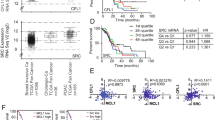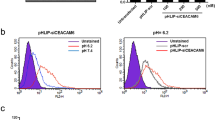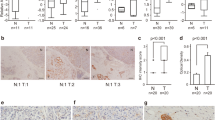Abstract
Anoikis is the apoptotic response induced in normal cells by inadequate or inappropriate adhesion to substrate. It is postulated that resistance to anoikis facilitates tumorigenesis and metastasis. Carcinoembryonic antigen-related cell adhesion molecule 6 (CEACAM6) is an immunoglobulin superfamily member overexpressed in a number of human cancers and implicated in anoikis resistance. We tested the effect of CEACAM6 gene silencing on anoikis in pancreatic adenocarcinoma cell lines. Anoikis was induced in PANC1, Capan2, MiaPaCa2 and MiaAR (a MiaPaCa2-derived anoikis-resistant subline) by culture in poly-2-hydroxyethylmethacrylate-coated wells. Anoikis was quantified by YO-PRO-1/propidium iodide staining and flow cytometry. The role of caspase activation was determined using fluorometric profiling and the caspase inhibitor Z-Val-Ala-Asp-fluoromethyl ketone (Z-VAD-fmk). CEACAM6 expression was suppressed by RNA interference. Using a nude mouse orthotopic xenograft model, we assessed the effect of this treatment on in vivo metastatic ability. Anoikis resistance was associated with increased CEACAM6 expression. CEACAM6-specific short interfering ribonucleic acid (siRNA), but not control siRNA, increased susceptibility to caspase-mediated anoikis, an effect abrogated by Z-VAD-fmk, and decreased Akt phosphorylation (Ser-473) under anchorage-independent conditions. CEACAM6 gene silencing reversed the acquired anoikis resistance of MiaAR and inhibited its in vivo metastatic ability. CEACAM6 warrants further investigation as a novel therapeutic target for the treatment of pancreatic adenocarcinoma.
This is a preview of subscription content, access via your institution
Access options
Subscribe to this journal
Receive 50 print issues and online access
$259.00 per year
only $5.18 per issue
Buy this article
- Purchase on Springer Link
- Instant access to full article PDF
Prices may be subject to local taxes which are calculated during checkout






Similar content being viewed by others
Change history
10 February 2023
This article has been retracted. Please see the Retraction Notice for more detail: https://doi.org/10.1038/s41388-023-02625-6
References
Arvelo F and Poupon MF . (2001). Acta Cient. Venez., 52, 304–312.
Attwell S, Roskelley C and Dedhar S . (2000). Oncogene, 19, 3811–3815.
Beauchemin N, Draber P, Dveksler G, Gold P, Gray-Owen S, Grunert F, Hammarstrom S, Holmes KV, Karlsson A, Kuroki M, Lin SH, Lucka L, Najjar SM, Neumaier M, OBrink B, Shively JE, Skubitz KM, Stanners CP, Thomas P, Thompson JA, Virji M, von Kleist S, Wagener C, Watt S and Zimmermann W . (1999). Exp. Cell Res., 252, 243–249.
Bouvet M, Wang J, Nardin SR, Nassirpour R, Yang M, Baranov E, Jiang P, Moossa AR and Hoffman RM . (2002). Cancer Res., 62, 1534–1540.
Brown D . (1993). Curr. Opin. Immunol., 5, 349–354.
Busch C, Hanssen TA, Wagener C and OBrink B . (2002). Hum. Pathol., 33, 290–298.
Chevinsky AH . (1991). Semin. Surg. Oncol., 7, 162–166.
Cournoyer D, Beauchemin N, Boucher D, Benchimol S, Fuks A and Stanners CP . (1988). Cancer Res., 48, 3153–3157.
Delcommenne M, Tan C, Gray V, Rue L, Woodgett J and Dedhar S . (1998). Proc. Natl. Acad. Sci. USA, 95, 11211–11216.
Downward J . (1998). Curr. Opin. Cell Biol., 10, 262–267.
Farrell TJ, Barbot DJ and Rosato FE . (1997). Ann. Surg., 226, 66–69.
Fidler IJ, Gersten DM and Hart IR . (1978). Adv. Cancer Res., 28, 149–250.
Folkman J and Moscona A . (1978). Nature, 273, 345–349.
Frisch SM and Francis H . (1994). J. Cell Biol., 124, 619–626.
Gardner-Thorpe J, Ito H, Ashley SW and Whang EE . (2002). Biochem. Biophys. Res. Commun., 293, 391–395.
Gorelik E, Kim M, Duty L, Henion T and Galili U . (1993). Clin. Exp. Metast., 11, 439–452.
Hasegawa T, Isobe K, Tsuchiya Y, Oikawa S, Nakazato H, Nakashima I and Shimokata K . (1993). Br. J. Cancer, 67, 58–65.
Ilantzis C, DeMarte L, Screaton RA and Stanners CP . (2002). Neoplasia, 4, 151–163.
Khwaja A, Rodriguez-Viciana P, Wennstrom S, Warne PH and Downward J . (1997). EMBO J., 16, 2783–2793.
Kim HR, Lin HM, Biliran H and Raz A . (1999). Cancer Res., 59, 4148–4154.
Kodera Y, Isobe K, Yamauchi M, Satta T, Hasegawa T, Oikawa S, Kondoh K, Akiyama S, Itoh K and Nakashima I . (1993). Br. J. Cancer, 68, 130–136.
Kunath T, Ordonez-Garcia C, Turbide C and Beauchemin N . (1995). Oncogene, 11, 2375–2382.
Kuroki M, Abe H, Imakiirei T, Liao S, Uchida H, Yamauchi Y, Oikawa S and Kuroki M . (2001). J. Leukoc. Biol., 70, 543–550.
Malek TR, Fleming TJ and Codias EK . (1994). Semin. Immunol., 6, 105–113.
Mayne KM, Pulford K, Jones M, Micklem K, Nagel G, van der Schoot CE and Mason DY . (1993). Br. J. Haematol., 83, 30–38.
McManus MT and Sharp PA . (2002). Nat. Rev. Genet., 3, 737–747.
Meredith Jr JE, Fazeli B and Schwartz MA . (1993). Mol. Biol. Cell, 4, 953–961.
Miknyoczki SJ, Chang H, Klein-Szanto A, Dionne CA and Ruggeri BA . (1999). Clin. Cancer Res., 5, 2205–2212.
Neumaier M, Paululat S, Chan A, Matthaes P and Wagener C . (1993). Proc. Natl. Acad. Sci. USA, 90, 10744–10748.
Oikawa S, Inuzuka C, Kuroki M, Arakawa F, Matsuoka Y, Kosaki G and Nakazato H . (1991). J. Biol. Chem., 266, 7995–8001.
Ordonez C, Screaton RA, Ilantzis C and Stanners CP . (2000). Cancer Res., 60, 3419–3424.
Perugini RA, McDade TP, Vittimberga Jr FJ and Callery MP . (2000). J. Surg. Res., 90, 39–44.
Qiao L, Koutsos M, Tsai LL, Kozoni V, Guzman J, Shiff SJ and Rigas B . (1996). Cancer Lett., 107, 83–89.
Radeva G, Petrocelli T, Behrend E, Leung-Hagesteijn C, Filmus J, Slingerland J and Dedhar S . (1997). J. Biol. Chem., 272, 13937–13944.
Raz A and Ben Ze'ev A . (1983). Science, 221, 1307–1310.
Robinson P and Hederer R . (1994). Braz. J. Med. Biol. Res., 27, 263–267.
Scholzel S, Zimmermann W, Schwarzkopf G, Grunert F, Rogaczewski B and Thompson J . (2000). Am. J. Pathol., 156, 595–605.
Semba S, Moriya T, Kimura W and Yamakawa M . (2003). Pancreas, 26, 250–257.
Shanmugathasan M and Jothy S . (2000). Pathol. Int., 50, 273–279.
Skubitz KM, Campbell KD and Skubitz AP . (2001). J. Pept. Res., 58, 515–526.
Soeth E, Wirth T, List HJ, Kumbhani S, Petersen A, Neumaier M, Czubayko F and Juhl H . (2001). Clin. Cancer Res., 7, 2022–2030.
Stanners CP and Fuks A . (1998). Cell Adhesion and Communication Mediated by the CEA family: Basic and Clinical Perspective. Stanners CP (ed), 5, 57–71.
Streuli CH and Gilmore AP . (1999). J. Mammary. Gland. Biol. Neoplasia, 4, 183–191.
Tan MH and Chu TM . (1985). Tumour Biol., 6, 89–98.
Thompson JA, Grunert F and Zimmermann W . (1991). J. Clin. Lab. Anal., 5, 344–366.
Wang W, Waters SJ, MacDonald JR, Von Hoff DD, Strodel WE and Miller AR . (2001). Anticancer Res., 21, 1789–1794.
Wirth T, Soeth E, Czubayko F and Juhl H . (2002). Clin. Exp. Metast., 19, 155–160.
Yao Z, Okabayashi Y, Yutsudo Y, Kitamura T, Ogawa W and Kasuga M . (2002). Pancreas, 24, 42–46.
Yawata A, Adachi M, Okuda H, Naishiro Y, Takamura T, Hareyama M, Takayama S, Reed JC and Imai K . (1998). Oncogene, 16, 2681–2686.
Zhu Z, Sanchez-Sweatman O, Huang X, Wiltrout R, Khokha R, Zhao Q and Gorelik E . (2001). Cancer Res., 61, 1707–1716.
Acknowledgements
We acknowledge the technical assistance provided by Jan Rounds. This work was supported by The National Pancreas Foundation and by departmental funds from the Department of Surgery, Brigham and Women's Hospital.
Author information
Authors and Affiliations
Corresponding author
About this article
Cite this article
Duxbury, M., Ito, H., Zinner, M. et al. RETRACTED ARTICLE: CEACAM6 gene silencing impairs anoikis resistance and in vivo metastatic ability of pancreatic adenocarcinoma cells. Oncogene 23, 465–473 (2004). https://doi.org/10.1038/sj.onc.1207036
Received:
Revised:
Accepted:
Published:
Issue Date:
DOI: https://doi.org/10.1038/sj.onc.1207036
Keywords
This article is cited by
-
New CEACAM-targeting 2A3 single-domain antibody-based chimeric antigen receptor T-cells produce anticancer effects in vitro and in vivo
Cancer Immunology, Immunotherapy (2024)
-
MicroRNA 29a therapy for CEACAM6-expressing lung adenocarcinoma
BMC Cancer (2023)
-
Tripartite motif–containing 9 promoted proliferation and migration of bladder cancer cells through CEACAM6-Smad2/3 axis
Journal of Cell Communication and Signaling (2023)
-
Identification of key genes for HNSCC from public databases using bioinformatics analysis
Cancer Cell International (2021)
-
Tumor levels of the mediators of ErbB2-driven anoikis resistance correlate with breast cancer relapse in patients receiving trastuzumab-based therapies
Breast Cancer Research and Treatment (2021)



